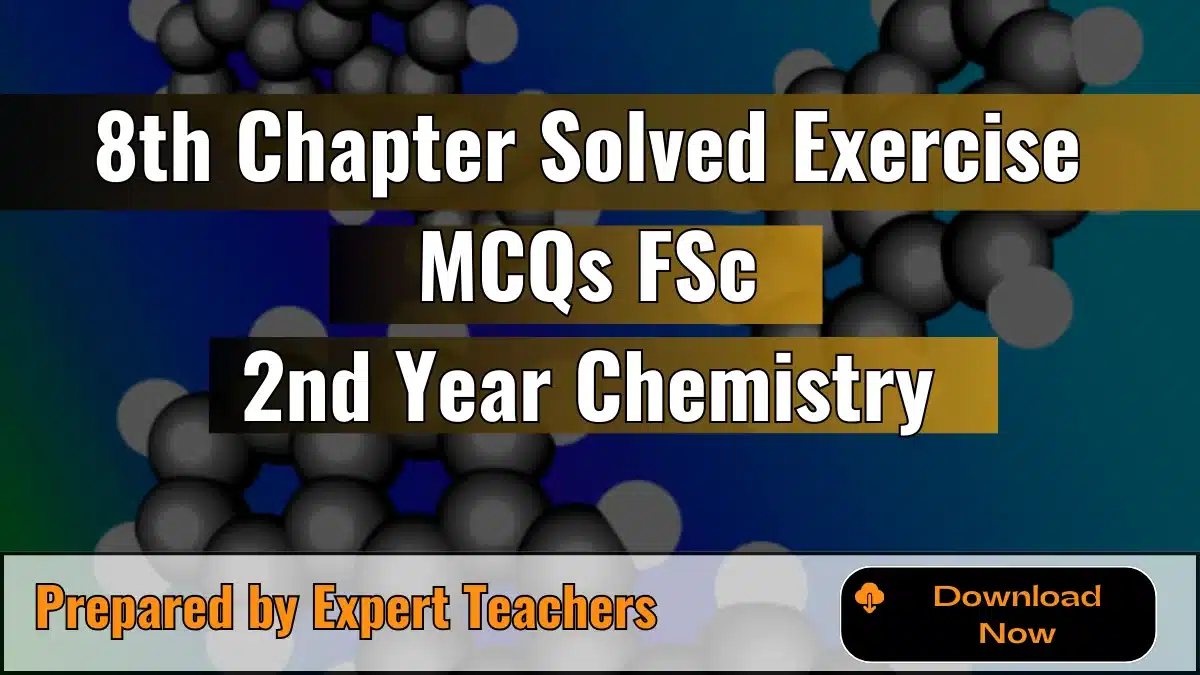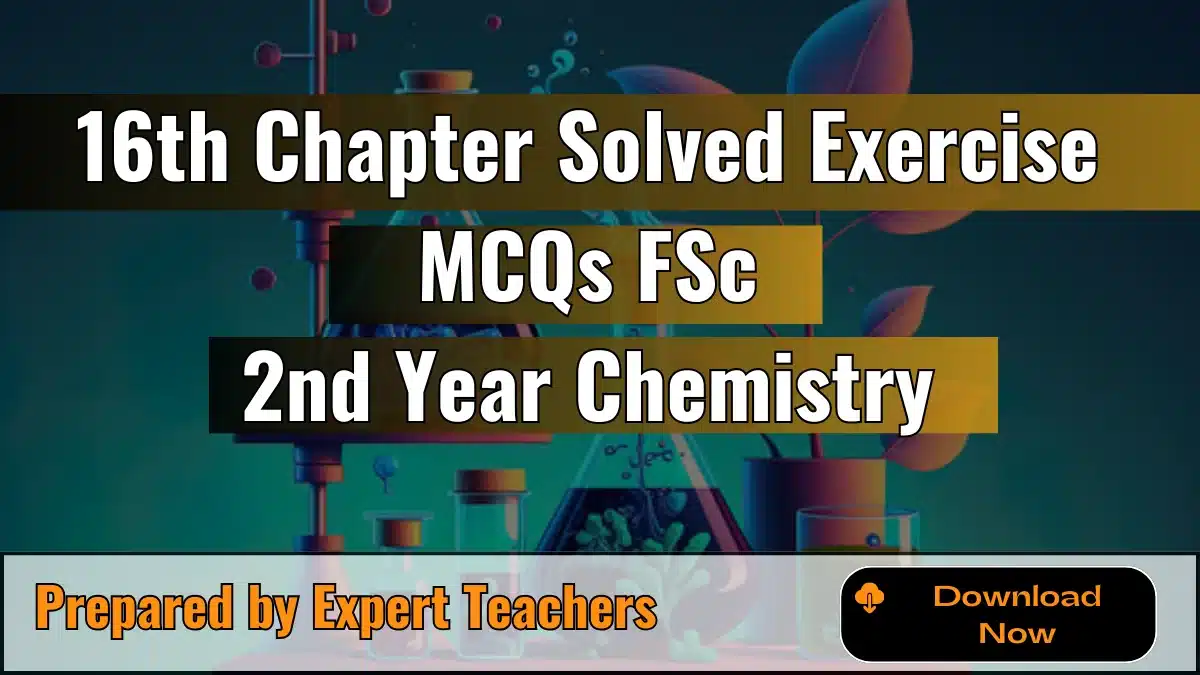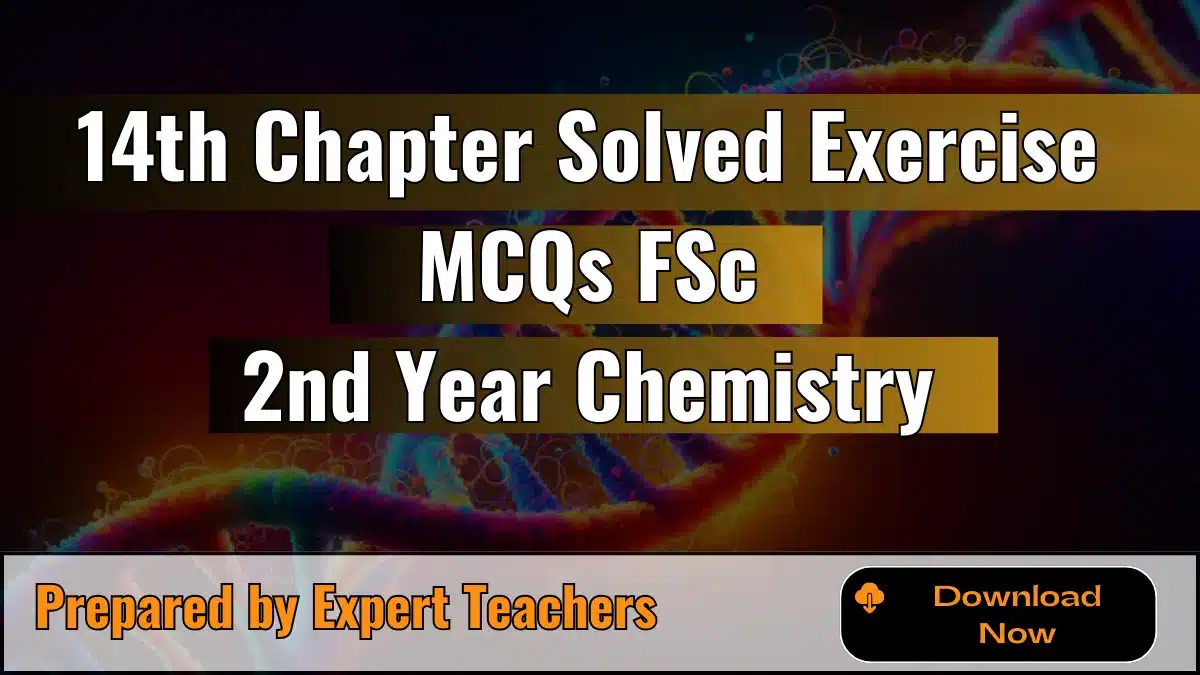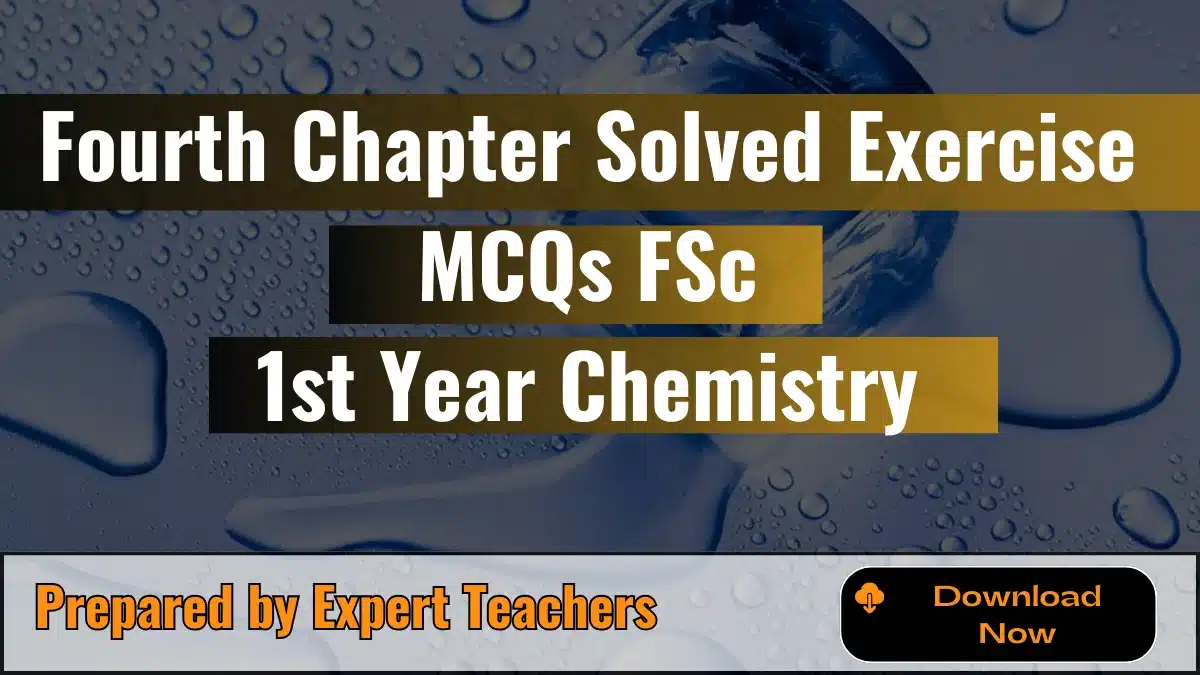11th Chapter Solved Exercise MCQs of FSC Second Year Chemistry
The 11th Chapter Solved Exercise MCQs of FSC 2nd-year Chemistry provides a complete set of solved multiple-choice questions (MCQs). Each MCQ comes with a brief explanation to help you understand the correct answer. These solutions are designed to support students in preparing for their exams, making complex concepts easier to grasp and ensuring a solid foundation for success.
11th chapter solved MCQs with explanation
1. Which compound shows hydrogen bonding?
(a) C₂H₆
(b) C₂H₅Cl
(c) CH₃-O-CH₃
(d) C₂H₅OH
Explanation: Option (d) is correct. Because hydrogen bonding occurs when hydrogen is bonded to a highly electronegative atom like oxygen, nitrogen, or fluorine. In C₂H₅OH (ethanol), the hydroxyl group (-OH) allows for hydrogen bonding because the hydrogen is directly bonded to the electronegative oxygen atom.
In contrast:
- C₂H₆ (ethane) lacks any highly electronegative atoms.
- C₂H₅Cl (ethyl chloride) contains chlorine, which is not as capable of hydrogen bonding as oxygen.
- CH₃-O-CH₃ (dimethyl ether) has an oxygen atom, but its structure only has dipole-dipole interactions.
2. Which compound shows maximum hydrogen bonding with water?
(a) CH₃OH
(b) C₂H₅OH
(c) CH₃-O-CH₃
(d) C₆H₅OH
Explanation: Option (b) is correct. Because
- Hydrogen bonding occurs when a hydrogen atom, covalently bonded to a highly electronegative atom (like oxygen or nitrogen), interacts with a lone pair of electrons on another electronegative atom.
- Ethanol (C₂H₅OH) has a hydroxyl group that is able to form multiple hydrogen bonds with water molecules. The size and structure of the molecule also help it mix well with water compared to phenol.
3. Which compound is more soluble in water?
(a) C₂H₅OH
(b) C₆H₅OH
(c) CH₃COCH₃
(d) n-Hexanol
Explanation: Option (a) is correct. Because
- (a) C₂H₅OH (Ethanol): Small molecule, -OH group forms hydrogen bonds, high solubility.
- (b) C₆H₅OH (Phenol): -OH group but large hydrophobic benzene ring, lower solubility.
- (c) CH₃COCH₃ (Acetone): Polar, can form hydrogen bonds but less effectively than ethanol.
- (d) n-Hexanol: Long hydrophobic chain, less soluble despite -OH group.
4. Which compound will have the maximum repulsion with H₂O?
(a) C₆H₆
(b) C₂H₅OH
(c) CH₃CH₂CH₂OH
(d) CH₃—O—CH₃
Explanation: Option (a) is correct. Because
5. Ethanol can be converted into ethanoic acid by:
(a) Hydrogenation
(b) Hydration
(c) Oxidation
(d) Fermentation
Explanation: Option (c) is correct. Because oxidation involves the addition of oxygen or the removal of hydrogen. In this process, ethanol is oxidized by agents such as potassium permanganate (KMnO₄) or chromium trioxide (CrO₃), which converts it into ethanoic acid.
Other options:
- Hydrogenation: Adds hydrogen; not applicable here.
- Hydration: Adds water; not applicable.
- Fermentation: Converts sugars to ethanol; not relevant for this conversion.
6. Which enzyme is not involved in fermentation of starch?
(a) Diastase
(b) Zymase
(c) Urease
(d) Invertase
Explanation: Option (c) is correct. Because fermentation of starch primarily involves the breakdown of starch into sugars and then the conversion of these sugars into alcohol and carbon dioxide.
- Diastase (a type of amylase) helps convert starch into maltose (a sugar).
- Zymase converts sugars into ethanol and carbon dioxide.
- Invertase breaks down sucrose into glucose and fructose, which can then be fermented.
- Urease, on the other hand, is an enzyme that breaks down urea into ammonia and carbon dioxide. It is not involved in the fermentation of starch.
7. Which compound is called a universal solvent?
(a) H₂O
(b) CH₃OH
(c) C₂H₅OH
(d) CH₃—O—CH₃
Explanation: Option (a) is correct. Because water can dissolve many substances due to its polar nature. The slight positive and negative charges on water molecules allow them to attract and separate particles of other polar or ionic substances, making water very effective at dissolving them.
Other compounds like CH₃OH (methanol), C₂H₅OH (ethanol), and CH₃—O—CH₃ (dimethyl ether) are less effective at dissolving a wide range of substances compared to water.
8. Methyl alcohol is not used:
(a) as a solvent
(b) as an anti-freezing agent
(c) as a substitute for petrol
(d) for denaturing of ethyl alcohol
Explanation: Option (c) is correct. Because methyl alcohol (methanol) doesn’t provide as much energy and can damage car engines. It’s useful for other things, but it’s not good for running regular cars like petrol does.
9. Rectified spirit contains alcohol methyl about:
(a) 80%
(b) 85%
(c) 90%
(d) 95%
Explanation: Option (d) is correct. Because rectified spirit is a highly concentrated form of ethanol that contains about 95% ethanol and 5% water. It is obtained by repeated distillation of ethanol and cannot exceed 95.6% purity due to the formation of an azeotropic mixture with water at this concentration.
10. According to Lewis concept ethers behave as:
(a) Acid
(b) Base
(c) Acid as well as a base
(d) None of them
Explanation: Option (b) is correct. Because in the Lewis concept, a base is defined as a substance that can donate an electron pair. Ethers have lone pairs of electrons on the oxygen atom, which they can donate to form coordinate bonds. This ability to donate an electron pair makes ethers Lewis bases. They do not have the ability to accept an electron pair to act as Lewis acids.







Leave a Reply